"ὑμεῖς προσκυνεῖτε ὃ οὐκ οἴδατε."
"You people believe what you don't even know."
Jesus to the Samaritan woman of Sychar, John 4:22
 HIS IS THE STORY of the Samaritan woman at the well (John 4:7-45; cf. the story about the Canaanite woman in the synoptic gospels, Matthew 7:24-30, Mark 15:21-28, notably missing from Luke before 9:10)--
HIS IS THE STORY of the Samaritan woman at the well (John 4:7-45; cf. the story about the Canaanite woman in the synoptic gospels, Matthew 7:24-30, Mark 15:21-28, notably missing from Luke before 9:10)--
Jesus and his disciples were passing through Samaria on their way back to their homes in Galilee after spending Passover in Jerusalem. They stopped to rest in the city of Shechem (nicknamed Sychar, "Falsehood," by the Jews) lying in the valley between Mount Ebal to the south and the Samaritans' holy mountain, Mount Gerizim, to the north. Here was the site of the famous pilgrimage Jacob's Well, and it was here that Jesus encountered a local woman.
In the course of their conversation he told her intimate details about her personal life that he couldn't have known, and she recognized him as a prophet. As such he could arbitrate disputes of religious doctrine, so she asked him point-blank, "Where must we worship God, on our mountain as we have always believed or in Jerusalem as you Jews say?"
Jesus smiled as he dodged the question. "You people don't know what you believe," he said. He told her that this point of schism, which had separated the Jews from the Samaritans since the time of Moses (according to Samaritan tradition) or at least since the Babylonian captivity (according to Jewish tradition), was no longer relevant because he Jesus was the Messiah, something the woman had suspected all along apparently. This was the first time that Jesus Christ had declared himself to be the Messiah, and he delivered this world-changing revelation almost casually to a Samaritan woman of Shechem.
She took this good news with her back to the city and in two days Jesus and his disciples made many converts among the Samaritans.
Time marched on. In 72 the emperor Vespasian (Domitian's father) razed Shechem to the ground and built a new city on the dust and ashes, calling it Neapolis (New City). This became the modern Nablus, Palestine, home today of the Palestinian Securities Exchange. It is also the home--and I find this absolutely astounding--of two minority communities, a Christian community and a Samaritan community!
I mean--the mind reels!
I mean--could these Christians be, after two millennia, the descendants of the Samaritan Christians converted in those two days? And the Samaritans, I mean--who knew there were still actual Samaritans living in the world? Well, there are! There are actually only about 700 of them today, but they constitute a fourth surviving religion in the Abrahamic tradition, a fourth People of the Book!
* * *
Here is a coin in the collection from the city of Neapolis, struck by Domitian in the year 86/7 (RPC 2224 var)--
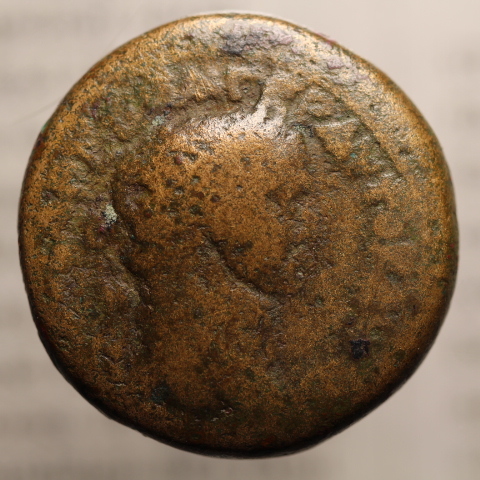
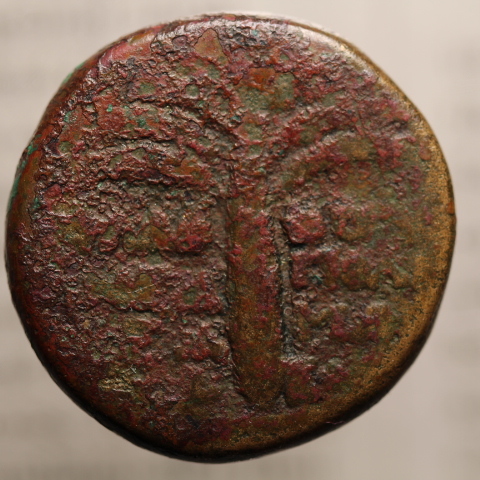
It galls me to have to admit it, but here is a better picture, at least one whose reverse might better illustrate my point, taken by Classical Numismatist Marc Breitsprecher, from whom I bought the coin--
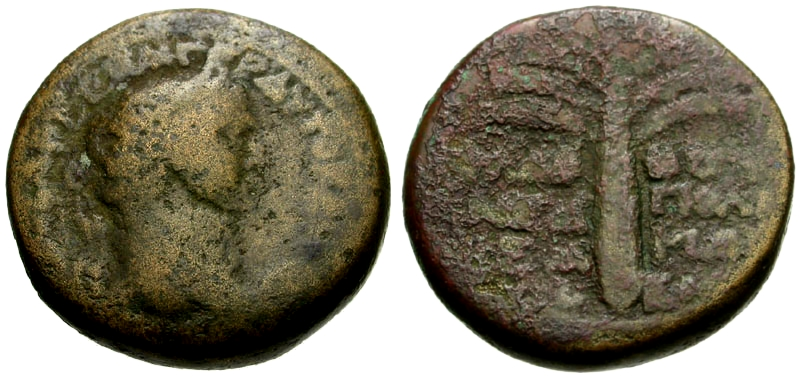
For comparison purposes, here is another coin with the same reverse type struck in Neapolis, Samaria, three years earlier, in 82/83--


It is worth noting that on neither of these coins, nor on any of the coins of Neapolis, is there any depiction of a pagan divinity. In my opinion this confirms that the inhabitants of the new city were the same former inhabitants of Shechem, that is to say, Samaritans, with the same strictures against handling graven images of false idols as the Jews. So, after Vespasian burned the first city to the ground, the people who built the new city over the ashes of Shechem were probably the original inhabitants of old Shechem.
In order to assess an important difference, here again are the obverse sides of the two coins, RPC 2220 on the left and RPC 2224 var on the right--

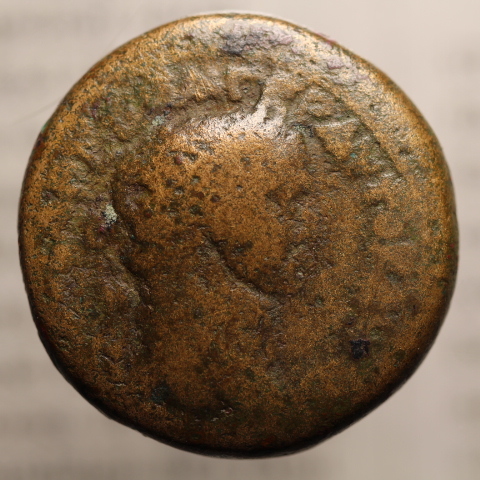
Note the inscriptions. On the left, clockwise beginning at about two o'clock, ΑΥΤΟΚ [ΔΟΜΙ]ΤΙΑΝΟΣ ΚΑΙΣΑΡ ΣΕΒΑΣΤΟΣ. On the right, RPC 2224 var, again beginning at about 2 o'clock and reading clockwise, ΑΥΤΟΚ ΔΟΜΙΤΙΑΝΟΣ ΚΑΙΣΑΡ ΣΕΒΑ ΓΕΡ, of which only ΑΥΤΟΚ ΔΟ. . .ΣΕΒΑ ΓΕΡ is legible. Particularly note the abbreviation ΓΕΡ at the very top of the coin, the Γ just before the laurel wreath, the E touched by the laurel wreath, and the P just after the laurel leaf. If you can't make it out on my photo, Marc's is better. I will explain the significance of this difference in the two inscriptions in a moment. Before I do that, though, here are the reverse sides of the two coins--

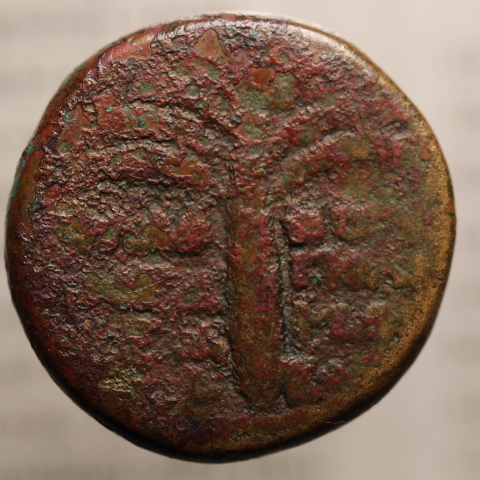
Note the fourth line of inscription on the two coins, L AI on the left and L EI on the right. (Again, Marc's photo is clearer.) This represents the CY, City Year, or the date. Last week I pointed out that the L wasn't an L but an Egyptian hieroglyphic symbol for year; apparently it was used throughout the Levant. L AI=year eleven and L EI=year fifteen, so CY 11 for the coin on the left (AD 82/3) and CY 15 (AD 86/7) for the coin on the right.
Emperor Domitian didn't assume the title Germanicus until late 83, in CY 12 of Neapolis, L BI, though there were no coins struck in Neapolis that year. The Latin abbreviation GER for GERMANICVS is rendered ΓΕΡ in Greek, as it is inscribed on the face of RPC 2224 var. Thus the dates on the reverse sides of the two coins corroborate the different inscriptions on the obverse sides, meaning there could not be a coin with an obverse inscription reading ΓΕΡ and a reverse inscription reading L AI. I hope that's clear.
So what?
The city of Neapolis struck two issues in the the time of Domitian, dated L AI and L EI, as I explained above. L AI is a fairly common issue, but L EI is extremely rare. In fact of the five denominations of coins minted in Neapolis, only three denominations of the L EI issue have been cataloged. RPC (Andrew Burnett, Michael Amandry, and Ian Carradice, Roman Provincial Coinage, Volume II, London, Paris, 1999) provides an excellent table that shows the gaps, which I will try to reproduce here but with RPC I.D. numbers in the slots instead of weight in grams--

The numerals within brackets represent the number of examples for each year and denomination found in the major collections. The "This coin" in the table above is my own RPC 2224 var. Q.E.D., it fits right in the slot, an unpublished coin! One of several in the Hazelton coll., but, yay, hey hey, whoopee, etc.!
Okay, but here's the really funny thing: RPC has already published this little coin of mine! It is cited under RPC 2220 as "RPC 2220.21. Lindgren 2430." This coin came to me by way of Marc's list from the Lindgren coll. itself (Lindgren 2430, Henry Clay Lindgren and Frank L Kovaks, Ancient Bronze Coins of Asia Minor and the Levant from the Lindgren Collection, San Francisco, 1985) where it was published along with a plate. Although the obverse inscription is correctly transcribed in Lindgren the reverse inscription is wrong (reading L AI), and then later it was subsequently misidentified in RPC.
So there you have it, a twice-published unpublished coin!
Next: 30 Days Hath Germanicus: The interstitial GEM issue of 86

